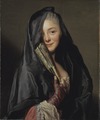Plik:The Lady with the Veil (the Artist's Wife) (Alexander Roslin) - Nationalmuseum - 21152.tif

Wielkość pliku podglądu JPG dla pliku TIF: 500 × 600 pikseli Inne rozdzielczości: 200 × 240 pikseli | 400 × 480 pikseli | 640 × 768 pikseli | 854 × 1024 pikseli | 1708 × 2048 pikseli | 2966 × 3557 pikseli.
Rozmiar pierwotny (2966 × 3557 pikseli, rozmiar pliku: 30,21 MB, typ MIME: image/tiff)
Historia pliku
Kliknij na datę/czas, aby zobaczyć, jak plik wyglądał w tym czasie.
| Data i czas | Miniatura | Wymiary | Użytkownik | Opis | |
|---|---|---|---|---|---|
| aktualny | 21:57, 7 paź 2016 |  | 2966 × 3557 (30,21 MB) | AndreCostaWMSE-bot | {{Artwork |other_fields_1 = {{depicted person|Suzanne Roslin|style=information field}} |artist = {{Creator:Alexander Roslin}} |title = {{en|The Lady with the Veil (the Artist's Wife)}} {{sv|Damen m... |
Lokalne wykorzystanie pliku
Żadna strona nie korzysta z tego pliku.
Globalne wykorzystanie pliku
Ten plik jest wykorzystywany także w innych projektach wiki:
- Wykorzystanie na ar.wikipedia.org
- Wykorzystanie na arz.wikipedia.org
- Wykorzystanie na cs.wikipedia.org
- Wykorzystanie na en.wikipedia.org
- Wykorzystanie na fr.wikipedia.org
- Wykorzystanie na hy.wikipedia.org
- Wykorzystanie na ko.wikipedia.org
- Wykorzystanie na outreach.wikimedia.org
- Wykorzystanie na sv.wikipedia.org
- Wykorzystanie na www.wikidata.org







